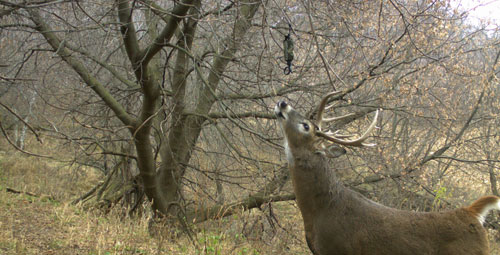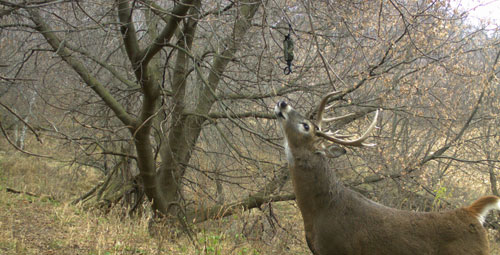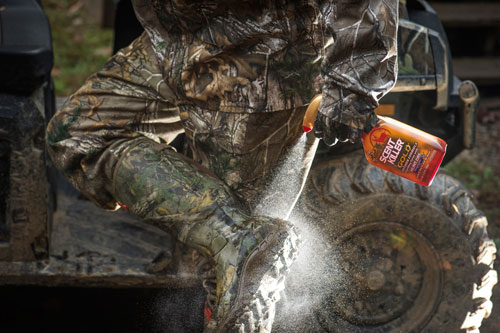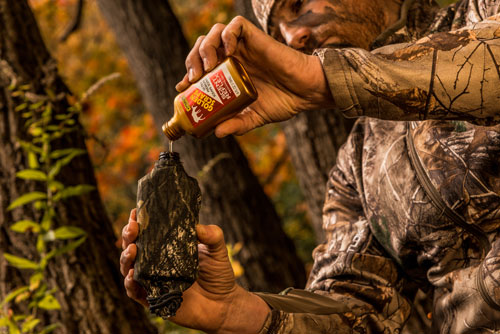We’ve all heard the same thing ever since we started deer hunting—big, mature whitetails are, generally speaking, nocturnal, moving around mostly or exclusively at night. That certainly could account for why so many deer hunters bemoan the fact that the biggest bucks that show up on their trail cameras do so only during the close of legal shooting hours.
So the question is, are big bucks really nocturnal? Maybe the question should be, “Do big bucks simply lie in their beds all day long for 12 hours or so at a stretch?” The answer, of course, is no. They get up, they move around, and they do deer things throughout the day. They just may not be moving around and doing deer things during the day in areas that correspond with your camera locations or anywhere that’s not close to their core bedding area. And that negates the notion that big bucks are exclusively nocturnal creatures.
Most mature bucks do move around during the day—they just do it in a relatively small area, the size of which depends on the personal quirks and habits of the buck. Some may cruise around in a 75- to 100-acre parcel, while others may only knock around in an acre or two during daylight hours.
What is generally true is that mature bucks hold tight to their core bedding area during the day, whether it’s pre- or post-rut. During the rut, however, that changes dramatically. Bucks go when and where their hormones guide them.
The obvious strategy for hunting pre-rut and post-rut bucks, therefore, is to target their bedding areas, since that is where they’ll most likely be when the sun is shining. The problem every veteran deer hunter knows, though, is that a buck’s bedding area is his impenetrable safe zone—his “Ft. Knox,” if you will. He chose this area for good reason. In it, he feels safe. Thick cover offers concealment. Strategic vantage points command the wind to detect scent or offer a visual high ground. A sure escape route will also be close at hand. Holding to a protected bedding area is how big bucks get old and big.
As a result, pre-rut hunting for the big ones requires some extra work and strategy—the most important of which includes identifying the target buck’s secret retreat and devising a means of either intercepting him as he enters it in the morning or exits it in the evening. You can also encourage him to come to a spot of your choosing (sort of) during daylight. That’s a tough strategy, but a doable one if you play the cards just right.
Location Identification
As we’ve said many, many times, the key to zeroing in on mature bucks is to learn their bedding area, or home turf, and discover the travel routes they take into and out of the area. On-the-ground observation, examining trail-cam photos, scouting and even studying satellite photos can help. Where you’ve seen a good buck in person or on camera, his hidey-hole is probably not too far off. Areas with heavy cover, vantage points and possibly close proximity to food and water sources are always good bets. The goal here is to define this area and then determine how he gets in and out of it. That intersection of the bedding area perimeter and the travel route is probably your best location to set up your stand. If you can verify this with a trail camera, so much the better.
Scent Control
Although bucks tend to take up long-term residence in areas where they feel safe, these are by no means permanent locations. Give him a snoot full of your scent and bump him out of his bedroom a time or two and you can lay good odds that he’ll find another place to call home.
Some of us tend to get a bit lax with scent management when we’re hunting just to fill the freezer, but if you’re targeting a mature buck, you need to run your scent game at 100 percent. This means never entering the area for hunting, scouting or setup without ensuring you are as scent-free as possible. Wash yourself from head-to-toe in a scent-eliminating wash, such as Scent Killer Gold Body Wash and Shampoo, and clean your clothes in Scent Killer Gold Laundry Detergent. Next, liberally apply Scent Killer Gold to your boots and clothing before stepping into the woods.
We all know that smell is a whitetail’s most critical defense, and they can smell us from a shockingly long distance. When you’re setting up your stand location (downwind or crosswind to where you anticipate your buck will make its appearance), try to do so only when the wind is not going to blow your scent into the bedding area.
Make a Happening
Now comes the training part of the equation. We say “training” with tongue somewhat firmly planted in cheek because getting a buck to do exactly what you want, when you want is about as reliable as herding cats. Rather, the aim is to do what you can to encourage a buck to show up during shooting light in your predetermined location. For this, a scrape dripper is your go-to.
Our favorite tool for this job is Wildlife Research Center’s Magnum Scrape Dripper. It’s an ingeniously simple device that dispenses the scent of your choice in small drips— only during daylight hours. Fill the bottle with up to 4 ounces of scent and hang it from a branch. As the daytime temperatures rise, so does air pressure inside the bottle, which pushes the liquid scent out in small drops. Depending on the weather/temperature conditions, those 4 ounces are enough to last two to three weeks before you need to refill.
We like to hang at least one Magnum Scrape Dripper over the scrape nearest our stand. If there are none around, we’ll make our own scrape and start the scent drip. Which type of scent we use usually depends on where we’re at in the season. Early in October, WRC’s Active Scrape is a good choice. This is a full-spectrum (buck and doe urine blend) scent with a time-release formulation that works well for piquing a buck’s curiosity as to who is showing up in his neighborhood. As the season progresses and the early rumblings of the rut begin, we’ll switch to a more arousing scent, such as Golden Scrape or the perennial favorite, Trail’s End #307.
The underlying theme here is to give your target buck a reason to step out of his bedroom while you are in the stand. Sure, there are some bucks that simply won’t budge until dark, but for many, the chance of finding out what other deer are coming around (mates or potential challengers) can be enough to make them show up in the sunlight. A scent system designed to deliver that enticement only during the daytime is a large step in achieving your goal.
The Final Fact
Of course, no matter what you do, what you try for setups, or anything else, always remember that if you’re not in your stand at dawn and at dusk, you’re chances of crossing paths with that big buck during the pre- and post-rut diminish significantly. A daylight-timed scent-dispersion strategy may provide you with a mid-day encounter with a mature buck, but this approach, combined with being in your stand a good hour before daylight and until legal shooting light is over, will give you your best shot.
— PAID PARTNER CONTENT. This content is brought to you by a D&DH advertising sponsor.




